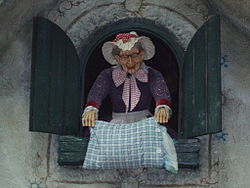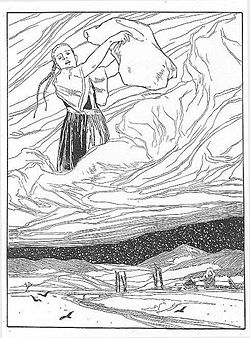- Mother Hulda
-
Mother Hulda is a German fairy tale collected by the Brothers Grimm and first published in 1812 as part of Children's and Household Tales. It was originally known as Frau Holle and is tale number 24.[1]
Contents
Synopsis
Mother Hulda tells the tale of a rich widow and her daughter and stepdaughter. The widow favored her biological daughter, allowing her to become spoiled and idle, while her stepdaughter was left to do all the work. Every day the stepdaughter would sit outside the cottage and spin beside the well. One day she pricked her finger on the point of the spindle. Leaning over the well to wash the blood away, the spindle fell from her hand and sank out of sight. The stepdaughter feared that she would be punished for losing the spindle, and in a panic she leapt into the well after it. To her surprise, the girl found herself in the other world of Hulda, who kept her as maidservant for several weeks. Hulda was so impressed by the girl's meekness and industry she sent her back to her family, with an apron full of gold.
The mother, thinking that her own daughter should have received the gold, sent the lazy daughter down the well to work for Mother Hulda. Copying her sister, the lazy daughter bloodied her finger and leapt into the well. But Hulda reproved her idle nature by sending her home covered with pitch.
Origins
The exact origin of Mother Hulda is difficult to trace but it is thought that the character originated in Norse mythology, where she is associated with a number of different deities including Frigg and Hel; also in German, there is an etymologic connection between the name Holle, the name Hel, and the word for hell (Hölle).
Hel is the queen of Hel, the Norse underworld, and described in Norse mythology as a half-dead, half alive monster, but in German mythology she was viewed with some beneficence, as a more gentle form of death and transformation. In this context, Mother Hulda is connected with Hertha, the goddess of peace and fertility, otherwise known as Hlodyn in the Edda. Hlodyn herself was more commonly referred to as Jord, the personification of the primitive, unpopulated, and uncultivated Earth. She is one of the wives of the chief god Odin and the mother of the god Thor. Since the term mother goddess is used interchangeably in various texts across Europe it is possible that some confusion exists over the exact status of Jord and Frigg in this context.
In early Germanic mythology however, Hulda was known as the goddess of marriage. She was a beneficent deity, the patroness and guardian of all maidens.
Marija Gimbutas[2] names Hulda (or Holda, Holla, Holle) as having originally been an ancient Germanic supreme goddess who predates most of the German pantheon, including deities such as Odin, Thor, Freya and Loki, continuing traditions of pre-Indo-European Neolithic Europe.
When Christianity slowly replaced Scandinavian paganism during the early Middle Ages, much of the old customs were gradually lost or assimilated into Catholic tradition. By the end of the High Middle Ages, Scandinavian paganism was almost completely marginalized and blended into rural folklore, in which the character of Mother Hulda eventually survived.
In Germanic Pre-Christian folklore, Hulda, Holda, Holle and Holla were all names to denote a single Goddess. One who rules the weather; sunshine, snow and rain. Hulda is also related to the Germanic figure of Perchta. She dwells at the bottom of a well, rides a wagon, and first taught the craft of making linen from flax. Hulda is the goddess to whom children who died as infants go, and alternatively known as both the Darth Großmutter (Dark Grandmother) and the Weissfrau (White Lady), elements which are more typically associated with the Grimm's fairy tale as well. Her connection to the spirit world through the magic of spinning and weaving has associated her with witchcraft in Catholic German folklore.
The legend itself, as it was eventually passed to the Grimm Brothers, originates from oral traditions in Central Germany in what is now known as Hesse. It was told to them by Henriette Dorothea Wild (whom Wilhelm Grimm married in 1825) with more details added in the second edition (1819). It is still common expression in Hesse to say "Hulda is making her bed" when it is snowing, that is, she shakes her bed and out comes snow from heaven!
Analysis
According to the Aarne and Thompson classification system of fairy tales, Mother Hulda is a story of type 480, The Kind and the Unkind Girls. Others of this type include Shita-kiri Suzume, Diamonds and Toads, The Three Heads in the Well, Father Frost, The Three Little Men in the Wood, The Enchanted Wreath, The Old Witch, and The Two Caskets.[3] Literary variants include The Three Fairies and Aurore and Aimée.[4]
Mother Hulda is one of Germany's most durable female legendary figures and one who without doubt represents a pre-Christian heathen deity who survived in popular belief and in the memory of common people well into the nineteenth century.
See also
References
- ^ Jacob and Wilheim Grimm, Household Tales, "Frau Holle (Mother Holle)"
- ^ Gimbutas, Marija, The Living Goddesses (Berkeley: University of California Press, 2001).
- ^ Heidi Anne Heiner, "Tales Similar to Diamonds and Toads"
- ^ Jack Zipes, The Great Fairy Tale Tradition: From Straparola and Basile to the Brothers Grimm, p 543, ISBN 0-393-97636-X
Categories:
Wikimedia Foundation. 2010.


